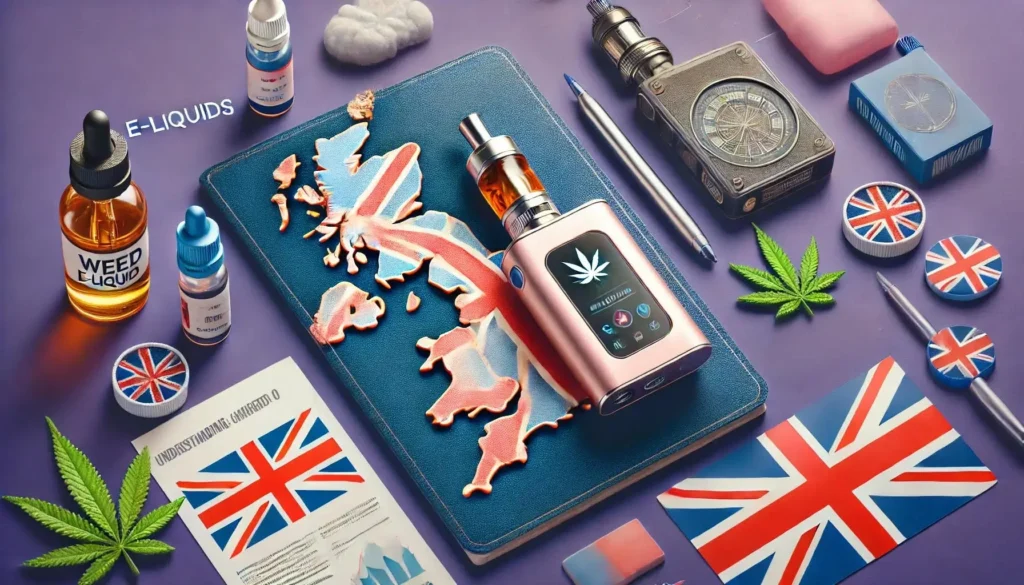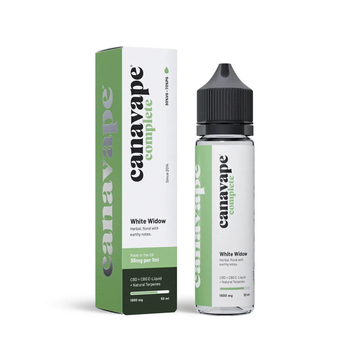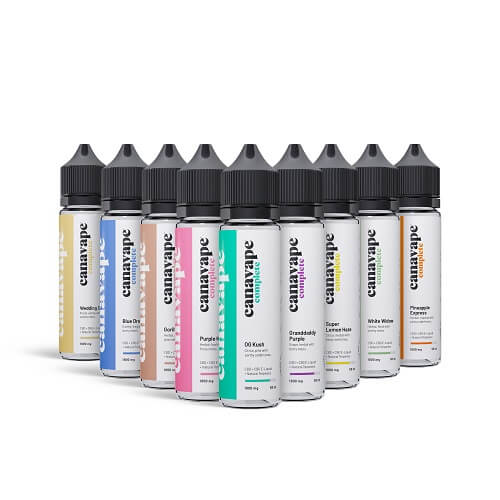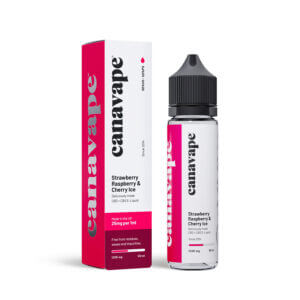
As the landscape of cannabis consumption continues to evolve, weed e-liquids have emerged as a popular choice for many UK consumers seeking a convenient and discreet alternative to traditional methods. These liquids, designed for use in vaporizers, offer a modern approach to enjoying cannabis, complete with a range of flavours and potency choices to suit diverse preferences. Understanding the nuances of weed e-liquids, from their composition to their effects, is essential for making informed choices and optimizing your experience. In this guide, we will delve into the essentials of weed e-liquids, providing practical insights and tips for both novices and seasoned users alike.

Weed e-liquids, also known as cannabis vape juices, are specially formulated liquids designed for use in vaporizers and e-cigarettes. These e-liquids typically contain cannabis extract, often in the form of THC (tetrahydrocannabinol) or CBD (cannabidiol), dissolved in a carrier liquid. The carrier liquid usually includes a mix of propylene glycol (PG) and vegetable glycerine (VG), which helps create the vapor when heated.
Weed e-liquids come in various flavours and potencies, catering to different preferences and tolerance levels. They offer a smokeless alternative to traditional cannabis consumption methods, providing a more discreet and potentially less harmful way to enjoy cannabis. Unlike smoking, vaping weed e-liquids does not produce combustion by-products, which might be appealing to health-conscious users. This makes them an attractive option for those looking to incorporate cannabis into their lifestyle with minimal fuss.
E-liquids originated alongside the development of electronic cigarettes, which were first introduced in the early 2000s as an alternative to traditional tobacco smoking. The initial focus was on nicotine-based e-liquids designed to help smokers transition away from cigarettes. Over time, the market expanded, and innovators began exploring the possibilities of infusing e-liquids with other substances, including cannabis.
By the 2010s, as cannabis legalization gained momentum in various countries, weed e-liquids started gaining popularity. This shift coincided with advancements in extraction technology, which allowed for the creation of high-quality cannabis concentrates suitable for vaping.
As the demand for more discreet, convenient, and health-conscious ways to consume cannabis grew, weed e-liquids emerged as a viable product. Canavape was the first cannabinoid vape liquid availble in Europe and the UK, as early as 2013!
Today, our products and many others continue to evolve, offering consumers a wide range of options in terms of flavor profiles and cannabinoid concentrations, thus becoming a staple in the modern cannabis market.
In the UK, the popularity of weed e-liquids has surged in recent years, mirroring trends seen in other countries where cannabis products are gaining acceptance. As legal frameworks around cannabis evolve and public perception shifts towards more liberal views on its use, consumers in the UK are increasingly exploring cannabis derivatives like weed e-liquids. This growth is partly attributed to the discreet nature of vaping, which appeals to those seeking privacy in their cannabis consumption. Additionally, the variety of flavors and strengths available caters to a broad spectrum of user preferences, from novice users to seasoned enthusiasts.
The convenience of weed e-liquids, which can be used with compact, portable devices, further enhances their appeal. Despite varying legality issues surrounding THC products in the UK, CBD-infused e-liquids have found a legal and popular niche, contributing significantly to the overall growth of the market. This trend reflects a broader societal shift towards alternative, health-oriented consumption methods.
Weed e-liquids consist of several key components that define their quality, flavor, and efficacy. The primary ingredient is the cannabis extract, which can be either THC or CBD, depending on the desired effects. This extract is typically derived through processes such as CO2 extraction, which ensures purity and potency. Alongside the cannabis extract, the e-liquid includes a carrier base, usually a mixture of propylene glycol (PG) and vegetable glycerin (VG).
These carriers are essential as they facilitate the vaporization process and influence the throat hit and cloud production. Flavorings are often added to enhance the user experience, offering a wide range of tastes from fruity to herbal. Additionally, some e-liquids like Canavape Complete may contain terpenes, natural compounds that contribute to the aroma and flavor of cannabis, providing an authentic experience.
Understanding these components helps consumers select e-liquids that best meet their preferences and needs, ensuring a satisfying vaping experience.

When exploring weed e-liquids, understanding the distinction between THC and CBD variants is crucial as they offer different experiences. THC (tetrahydrocannabinol) is the psychoactive compound responsible for the “high” associated with cannabis, making THC e-liquids popular among those seeking recreational effects. These e-liquids are often regulated, as THC is controlled in many jurisdictions, including the UK.
On the other hand, CBD (cannabidiol) e-liquids are non-psychoactive and have gained traction due to their potential therapeutic benefits. Users often turn to CBD for its reputed calming effects, making it suitable for those interested in wellness applications. Both types of e-liquids typically use similar carrier bases and flavorings, but the choice between them largely depends on the desired effects and legal considerations.
Understanding these key differences helps consumers make informed decisions about which type to use, aligning with their personal preferences and legal obligations.
Weed e-liquids often include various additives and flavors to enhance the vaping experience, appealing to a wide range of consumer preferences. Flavorings are a significant component, offering everything from fruit and candy flavors to more complex profiles like desserts or beverages. These flavorings are usually food-grade and safe for inhalation, crafted to complement the natural taste of cannabis or provide a unique twist.
Besides flavors, some e-liquids contain terpenes, which are organic compounds found in cannabis that contribute to its aroma and flavor, providing an authentic touch to the vaping experience. Additives like sweeteners might also be present to enhance the taste. However, it’s crucial for consumers to be aware of these ingredients, as some might prefer a purer product without artificial additives.
Understanding the role of these components helps users select e-liquids that best match their taste preferences and desired vaping experience, balancing flavor with the natural essence of cannabis.
In the UK, the legal landscape surrounding weed e-liquids is complex and primarily hinges on the distinction between THC and CBD. THC is classified as a controlled substance under the Misuse of Drugs Act 1971, making e-liquids containing THC illegal for sale or possession. This regulation reflects the government’s stance on psychoactive substances and aims to control their distribution.
Conversely, CBD, which is non-psychoactive, is legal and widely available as long as it meets certain criteria. CBD products, including e-liquids, must contain less than 0.2% THC to be compliant with UK law. Additionally, these products should not make any medical claims unless they are authorized as a medicinal product. The Food Standards Agency (FSA) also requires CBD food products to undergo a novel food application to ensure consumer safety. Understanding these regulations is essential for consumers and businesses to navigate the legalities of weed e-liquids in the UK responsibly.
For consumers in the UK, understanding the legal considerations surrounding weed e-liquids is crucial to ensure compliance with national laws. First and foremost, it’s important to verify that any e-liquid purchased contains CBD rather than THC, as THC-infused products are illegal in the UK. Consumers should look for products that clearly state the THC content is below the legal threshold of 0.2%.
Additionally, reputable products often provide third-party lab testing results to validate their claims, offering transparency and safety assurance. Manufacturers go one step further ensuring all ingredients they use are fully screened prior to use.
Consumers should also be cautious of any e-liquid making unsubstantiated health claims, as these are not permitted unless the product is licensed as medicine. Being informed about these legal aspects helps consumers make safe and lawful choices, avoiding potential legal repercussions associated with illicit cannabis products.
The legal landscape for weed e-liquids in the UK is poised for potential changes as discussions around cannabis reform continue. There is growing public support for revisiting cannabis laws, with debates focusing on both medicinal and recreational use. This evolving dialogue might influence future legislation, potentially relaxing restrictions on THC products.
Policymakers are increasingly considering the economic and health implications of cannabis regulation, which could lead to more permissive laws. However, any changes are likely to be gradual and will require comprehensive frameworks to ensure product safety and consumer protection. The UK government may also look to other countries with more liberal cannabis laws for guidance, assessing the impact of such regulations.
For consumers and businesses alike, staying informed about these possible developments is important, as they could significantly alter the market landscape. Keeping abreast of policy shifts will help stakeholders prepare for and adapt to new legal conditions in the cannabis industry.
Selecting the right weed e-liquid involves several factors that cater to individual preferences and legal considerations. First, determine whether you’re interested in a THC or CBD product, considering the psychoactive effects of THC and the therapeutic potential of CBD. Check the THC content to ensure compliance with local regulations, particularly in the UK, where products must have less than 0.2% THC.
Flavor preference is another key consideration, as e-liquids come in a wide range of tastes from fruity to herbal. Additionally, evaluate the product’s potency to match your tolerance level and desired effects. Look for brands that provide third-party lab testing to verify purity and potency, ensuring you receive a safe and reliable product. Consider the viscosity of the e-liquid, as some vaporizers may require specific formulations.
By weighing these factors, consumers can make informed choices that enhance their vaping experience while adhering to legal requirements.

When choosing weed e-liquids, comparing brands and prices is an essential step to ensure quality and value for money. Start by researching reputable brands known for transparency and quality assurance. Established brands often provide detailed information about their sourcing and manufacturing processes, along with third-party lab testing for their formulations. This transparency helps verify the purity and potency of their products.
Price comparison is equally important, as prices can vary significantly between brands and product lines. While it’s tempting to opt for the cheapest option, extremely low prices might indicate lower quality or misrepresentation of ingredients. Balance cost with quality by considering mid-range options from well-regarded brands, which often provide the best value.
Additionally, keep an eye out for customer reviews and ratings, as they offer insights into the product’s performance and user satisfaction. By carefully evaluating these elements, consumers can make informed decisions that align with their budget and quality expectations.
Understanding product labels on weed e-liquids is crucial for making informed purchases. Start by examining the cannabinoid content, which indicates the levels of THC and CBD. In the UK, it’s essential to ensure the THC content is below 0.2% to comply with legal standards. The label should also list the ingredients, including the carrier base components like propylene glycol (PG) and vegetable glycerin (VG), as well as any flavorings or additives.
Look for labels that disclose the source of the cannabis extract, as products made from organically grown plants often reflect higher quality. Labels might also provide usage instructions and storage recommendations to maintain product integrity. By paying close attention to these details, consumers can select safe and suitable e-liquids that meet their preferences and legal requirements, enhancing their overall vaping experience.
Weed e-liquids, particularly those containing CBD, are often explored for their potential health benefits. CBD, a non-psychoactive compound, is reputed for its calming effects and is frequently used to alleviate anxiety and stress. Some users report improved sleep quality and relief from chronic pain when using CBD e-liquids. Additionally, CBD is being studied for its anti-inflammatory properties, which may benefit individuals with conditions like arthritis. These potential benefits make CBD e-liquids appealing for those seeking holistic wellness options without the intoxicating effects of THC.
However, it’s important to note that while anecdotal evidence is plentiful, scientific research is still ongoing to fully understand the scope of CBD’s therapeutic effects. Users considering weed e-liquids for health purposes should consult with healthcare professionals to ensure they make safe and informed choices. This approach helps maximize benefits while minimizing any potential risks associated with vaping cannabis products.
While weed e-liquids offer a convenient way to consume cannabis, they are not without potential risks and side effects. One primary concern is the presence of harmful additives or contaminants, which can pose health risks when inhaled. Consumers should seek products from reputable brands with third-party lab testing to minimize these dangers. THC e-liquids may also induce psychoactive effects, including dizziness, anxiety, or paranoia, especially at higher doses or in inexperienced users.
Moreover, the long-term health impacts of vaping cannabis remain under study, necessitating cautious use. Users should start with low doses, gradually increasing as needed, and remain informed about potential side effects. Consulting with a healthcare professional can provide guidance tailored to individual health profiles, helping to mitigate risks while using weed e-liquids.
To ensure a safe vaping experience with weed e-liquids, consumers should adopt several best practices. Firstly, always purchase e-liquids from reputable sources that provide transparency about their products. Start with a low dosage, especially if you’re new to cannabis or trying a new product, to assess your tolerance and minimize adverse effects.
Pay attention to your vaping device’s settings, as using the correct temperature can prevent the combustion of harmful compounds. Regularly clean and maintain your vaporizer to ensure optimal performance and hygiene. Be mindful of where you vape, respecting public and private space regulations, and be aware of those around you who might be sensitive to vapors.
Lastly, consult with healthcare professionals if you have any underlying health conditions to tailor your use accordingly, ensuring a safe and enjoyable experience.